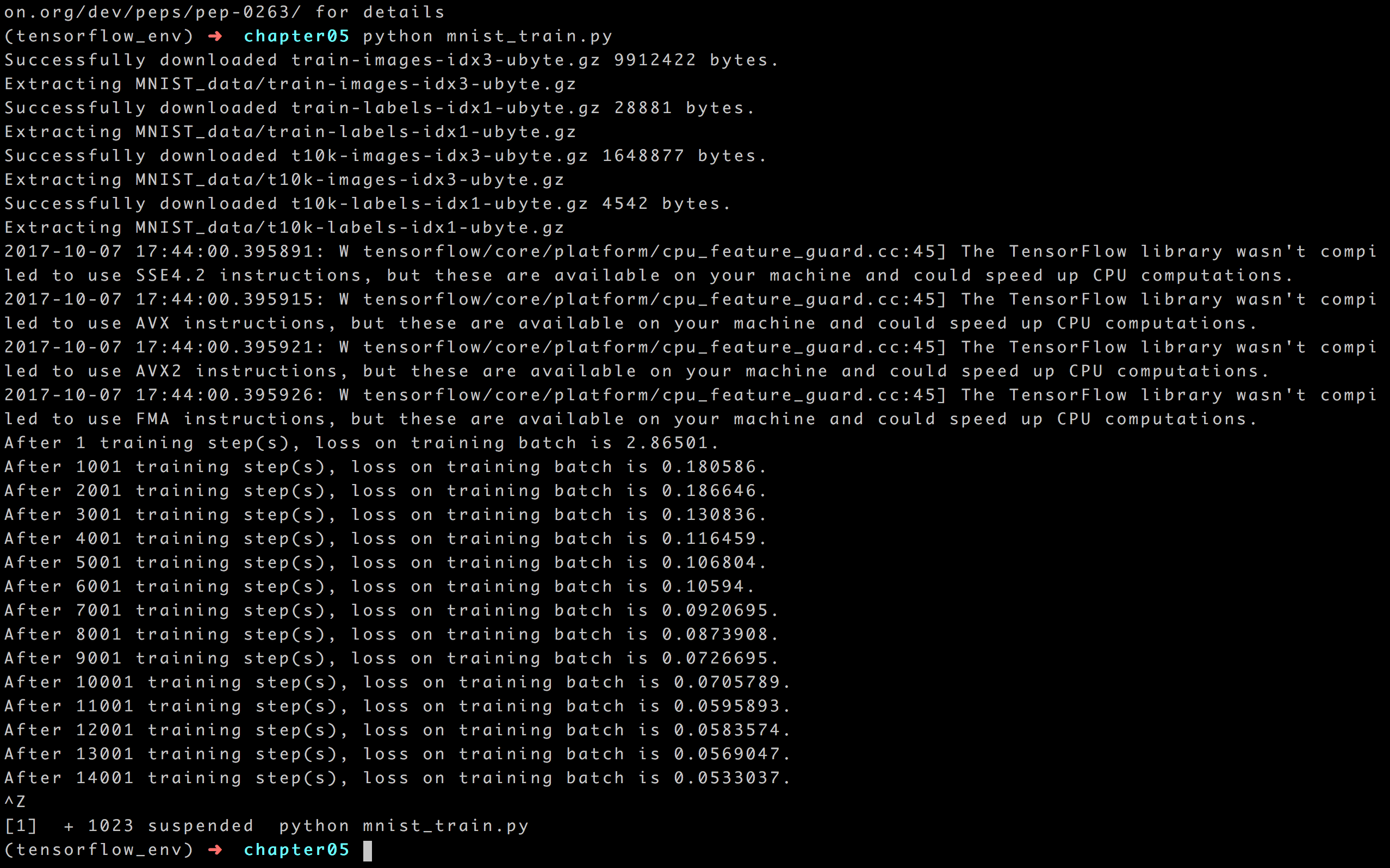Tensorflow 解决MNIST问题的重构程序
分为三个文件:mnist_inference.py:定义前向传播的过程以及神经网络中的参数,抽象成为一个独立的库函数;mnist_train.py:定义神经网络的训练过程,在此过程中,每个一段时间保存一次模型训练的中间结果;mnist_eval.py:定义测试过程。
mnist_inference.py:
#coding=utf8
import tensorflow as tf
#1. 定义神经网络结构相关的参数。
INPUT_NODE = 784
OUTPUT_NODE = 10
LAYER1_NODE = 500
#2. 通过tf.get_variable函数来获取变量。
def get_weight_variable(shape, regularizer):
weights = tf.get_variable("weights", shape, initializer=tf.truncated_normal_initializer(stddev=0.1))
if regularizer != None: tf.add_to_collection('losses', regularizer(weights))
return weights
#3. 定义神经网络的前向传播过程。使用命名空间方式,不需要把所有的变量都作为变量传递到不同的函数中提高程序的可读性
def inference(input_tensor, regularizer):
with tf.variable_scope('layer1'):
weights = get_weight_variable([INPUT_NODE, LAYER1_NODE], regularizer)
biases = tf.get_variable("biases", [LAYER1_NODE], initializer=tf.constant_initializer(0.0))
layer1 = tf.nn.relu(tf.matmul(input_tensor, weights) + biases)
with tf.variable_scope('layer2'):
weights = get_weight_variable([LAYER1_NODE, OUTPUT_NODE], regularizer)
biases = tf.get_variable("biases", [OUTPUT_NODE], initializer=tf.constant_initializer(0.0))
layer2 = tf.matmul(layer1, weights) + biases
return layer2
mnist_train.py:
#coding=utf8
import tensorflow as tf
from tensorflow.examples.tutorials.mnist import input_data
import mnist_inference
import os
#1. 定义神经网络结构相关的参数。
BATCH_SIZE = 100
LEARNING_RATE_BASE = 0.8
LEARNING_RATE_DECAY = 0.99
REGULARIZATION_RATE = 0.0001
TRAINING_STEPS = 30000
MOVING_AVERAGE_DECAY = 0.99
MODEL_SAVE_PATH="MNIST_model/"
MODEL_NAME="mnist_model"
#2. 定义训练过程。
def train(mnist):
# 定义输入输出placeholder。
x = tf.placeholder(tf.float32, [None, mnist_inference.INPUT_NODE], name='x-input')
y_ = tf.placeholder(tf.float32, [None, mnist_inference.OUTPUT_NODE], name='y-input')
regularizer = tf.contrib.layers.l2_regularizer(REGULARIZATION_RATE)
y = mnist_inference.inference(x, regularizer)
global_step = tf.Variable(0, trainable=False)
# 定义损失函数、学习率、滑动平均操作以及训练过程。
variable_averages = tf.train.ExponentialMovingAverage(MOVING_AVERAGE_DECAY, global_step)
variables_averages_op = variable_averages.apply(tf.trainable_variables())
cross_entropy = tf.nn.sparse_softmax_cross_entropy_with_logits(logits=y, labels=tf.argmax(y_, 1))
cross_entropy_mean = tf.reduce_mean(cross_entropy)
loss = cross_entropy_mean + tf.add_n(tf.get_collection('losses'))
learning_rate = tf.train.exponential_decay(
LEARNING_RATE_BASE,
global_step,
mnist.train.num_examples / BATCH_SIZE, LEARNING_RATE_DECAY,
staircase=True)
train_step = tf.train.GradientDescentOptimizer(learning_rate).minimize(loss, global_step=global_step)
with tf.control_dependencies([train_step, variables_averages_op]):
train_op = tf.no_op(name='train')
# 初始化TensorFlow持久化类。
saver = tf.train.Saver()
with tf.Session() as sess:
tf.global_variables_initializer().run()
for i in range(TRAINING_STEPS):
xs, ys = mnist.train.next_batch(BATCH_SIZE)
_, loss_value, step = sess.run([train_op, loss, global_step], feed_dict={x: xs, y_: ys})
if i % 1000 == 0:
print("After %d training step(s), loss on training batch is %g." % (step, loss_value))
saver.save(sess, os.path.join(MODEL_SAVE_PATH, MODEL_NAME), global_step=global_step)
def main(argv=None):
mnist = input_data.read_data_sets("MNIST_data", one_hot=True)
train(mnist)
if __name__ == '__main__':
main()
结果如下:

mnist_eval.py:
import time
import tensorflow as tf
from tensorflow.examples.tutorials.mnist import input_data
import mnist_inference
#coding=utf8
import mnist_train
#1. 每10秒加载一次最新的模型
# 加载的时间间隔。
EVAL_INTERVAL_SECS = 10
def evaluate(mnist):
with tf.Graph().as_default() as g:
x = tf.placeholder(tf.float32, [None, mnist_inference.INPUT_NODE], name='x-input')
y_ = tf.placeholder(tf.float32, [None, mnist_inference.OUTPUT_NODE], name='y-input')
validate_feed = {x: mnist.validation.images, y_: mnist.validation.labels}
y = mnist_inference.inference(x, None)
correct_prediction = tf.equal(tf.argmax(y, 1), tf.argmax(y_, 1))
accuracy = tf.reduce_mean(tf.cast(correct_prediction, tf.float32))
variable_averages = tf.train.ExponentialMovingAverage(mnist_train.MOVING_AVERAGE_DECAY)
variables_to_restore = variable_averages.variables_to_restore()
saver = tf.train.Saver(variables_to_restore)
while True:
with tf.Session() as sess:
ckpt = tf.train.get_checkpoint_state(mnist_train.MODEL_SAVE_PATH)
if ckpt and ckpt.model_checkpoint_path:
saver.restore(sess, ckpt.model_checkpoint_path)
global_step = ckpt.model_checkpoint_path.split('/')[-1].split('-')[-1]
accuracy_score = sess.run(accuracy, feed_dict=validate_feed)
print("After %s training step(s), validation accuracy = %g" % (global_step, accuracy_score))
else:
print('No checkpoint file found')
return
time.sleep(EVAL_INTERVAL_SECS)
def main(argv=None):
mnist = input_data.read_data_sets("MNIST_data", one_hot=True)
evaluate(mnist)
if __name__ == '__main__':
main()
结果如下:

Tensorflow 解决MNIST问题的重构程序的更多相关文章
- 深入浅出TensorFlow(二):TensorFlow解决MNIST问题入门
2017年2月16日,Google正式对外发布Google TensorFlow 1.0版本,并保证本次的发布版本API接口完全满足生产环境稳定性要求.这是TensorFlow的一个重要里程碑,标志着 ...
- tensorflow学习笔记——使用TensorFlow操作MNIST数据(2)
tensorflow学习笔记——使用TensorFlow操作MNIST数据(1) 一:神经网络知识点整理 1.1,多层:使用多层权重,例如多层全连接方式 以下定义了三个隐藏层的全连接方式的神经网络样例 ...
- 一个简单的TensorFlow可视化MNIST数据集识别程序
下面是TensorFlow可视化MNIST数据集识别程序,可视化内容是,TensorFlow计算图,表(loss, 直方图, 标准差(stddev)) # -*- coding: utf-8 -*- ...
- 基于tensorflow的MNIST手写数字识别(二)--入门篇
http://www.jianshu.com/p/4195577585e6 基于tensorflow的MNIST手写字识别(一)--白话卷积神经网络模型 基于tensorflow的MNIST手写数字识 ...
- tensorflow学习笔记——使用TensorFlow操作MNIST数据(1)
续集请点击我:tensorflow学习笔记——使用TensorFlow操作MNIST数据(2) 本节开始学习使用tensorflow教程,当然从最简单的MNIST开始.这怎么说呢,就好比编程入门有He ...
- Android+TensorFlow+CNN+MNIST 手写数字识别实现
Android+TensorFlow+CNN+MNIST 手写数字识别实现 SkySeraph 2018 Email:skyseraph00#163.com 更多精彩请直接访问SkySeraph个人站 ...
- win10下通过Anaconda安装TensorFlow-GPU1.3版本,并配置pycharm运行Mnist手写识别程序
折腾了一天半终于装好了win10下的TensorFlow-GPU版,在这里做个记录. 准备安装包: visual studio 2015: Anaconda3-4.2.0-Windows-x86_64 ...
- Tensorflow之MNIST的最佳实践思路总结
Tensorflow之MNIST的最佳实践思路总结 在上两篇文章中已经总结出了深层神经网络常用方法和Tensorflow的最佳实践所需要的知识点,如果对这些基础不熟悉,可以返回去看一下.在< ...
- tensorflow处理mnist(二)
用卷积神经网络解决mnist的分类问题. 简单的例子 一行一行解释这个代码. 这个不是google官方的例子,但是很简洁,便于入门.tensorflow是先定义模型,最后赋值,计算.为了讨论问题方便, ...
随机推荐
- DataTable转化成实体对象
/// <summary> /// The data extension. /// </summary> public static class DataExtension { ...
- 《F4+2》—团队项目系统设计改进与详细设计
一.团队项目系统设计改进: 1.分析项目系统设计说明书初稿的不足,特别是软件系统结构模型建模不完善内容 在上一次的项目系统设计说明书中没有很好的完成软件系统结构模型的建模设计,只做了基本的系统项目原型 ...
- Python 网络编程和Socket
2017-07-24 20:43:49 Socket又称"套接字",应用程序通常通过"套接字"向网络发出请求或者应答网络请求.Http协议主要的操作流程是req ...
- Eclipse 中 SDK无法更新---解决方法
在SDK Manager -> tools -> options中: HTTP Proxy Server: mirrors.neusoft.edu.cn HTTP Proxy Port: ...
- 20161226xlVBA演示文稿替换文字另存pdf
Const ModelText As String = "机构名称" Const ModelName As String = "测试文件.pptx" Sub N ...
- in_array的效率
in_array函数是个糟糕的选择.应该尽量用isset函数或array_key_exists函数来替代 .in_array函数的复杂度是O(n),而isset函数的复杂度是O(1) isset函数是 ...
- spfa毒瘤算法
终于知道怎么卡spfa(不优化)这一毒瘤算法了 下面就是造数据代码,点数才1e5,边数379980 随便测了一组数据: count: 831841219(入队次数) 68917.096 ms(足够t到 ...
- ASP.NET的路由系统
一.URL与物理文件的分离 1.URL与物理文件的分离 对于一个 ASP.NET Web Form应用来说,任何一个请求都对应着某个具体的物理文件.部署在Web服务器上的物理文件可以是静态的(比如图片 ...
- 深入理解$watch ,$apply 和 $digest --- 理解数据绑定过程——续
Angular什么时候不会自动为我们$apply呢? 这是Angular新手共同的痛处.为什么我的jQuery不会更新我绑定的东西呢?因为jQuery没有调用$apply,事件没有进入angular ...
- spring boot 学习(九)小工具篇:?秒防刷新
注解 + 拦截器:?秒防刷新 小工具篇:工具许多都是我以前在 github 之类开源平台找到的小工具类,作者的信息什么的许多都忘了.先说声不好意思了.若有相关信息,麻烦提醒一下~ 解释 所谓的?秒防刷 ...
